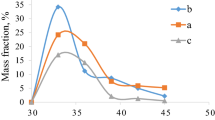Abstract
In the present work, polyaluminophenylsiloxanes have been obtained by two methods: the first one consisted in the exchange of sodium phenylsilanolate with aluminum chloride in an anhydrous medium (dimethyl sulfoxide-toluene), while the second one—in the reaction of aluminum acetylacetonate with polyphenylsiloxane under the conditions of mechanochemical activation. The polymers were purified by re-precipitation in the first case and by toluene extraction in the second case. The obtained aluminophenylsiloxanes have been studied by the methods of gel chromatography, diffractometry, and IR and 13C, 29Si, and 27Al NMR spectroscopy. It has been shown that the interaction under the conditions of mechanochemical activation proceeded in two directions: the Si–O–Si bond splitting reaction and the condensation reaction. A comparison of the physical and chemical characteristics of polyaluminophenylsiloxanes has been carried out, and it has been demonstrated that the structure of the PAlPhSi is structurally more homogeneous; aluminophenylsiloxy fragments were present along with siloxyaluminoacetylacetone fragments in PAl(acac)PhSi, which significantly complicated the polymer structure.











Similar content being viewed by others
References
Voronkov MG, Malyutina EA, Roman VK (1984) Heterosiloxanes. Nauka, Novosibirsk (In Russian)
Zhdanov AA, Levitskii MM (1989) Advances in the field of organometallic polymers. Nauka, Moscow (In Russian)
Levitskii MM, Zavin BG, Bilyachenko AN (2007) Chemistry of metallasiloxanes. current trends and new concepts. Usp Khim 76:907–926. https://doi.org/10.1070/RC2007v076n09ABEH003691 (In Russian)
Voronkov MG, Shapkin NP (1990) Phosphorus-containing polymetalloorganosiloxanes. J Organomet Chem 289:169–186
Zavin BG, Sergienko NV, Bilyachenko AN, Chirkun NV, Dronova MS, Korlyukov AA, Starikova OM, Levitskii MM, Timofeeva GI (2011) Synthesis of bimetallic cage-like metalloorganosiloxanes from polymeric metallosiloxanes. Izvestiya RAN 8:1621–1627. https://doi.org/10.1007/s11172-011-0246-0 (In Russian)
Igonin VA, Shchegolikhina OI, Lindeman SV, Struchkov YuT, Zhdanov AA (1991) Structures of complexes of copper with macrocyclic organosiloxanolate ligands. J Organomet Chem 423:351–356
Andrianov KA, Khanashvili LM (1973) Technology of organometallic monomers and polymers. Khimia, Moscow (In Russian)
Feher FI, Blanski RL (1990) Polyhedral oligometallasilsesquioxanes as models for silica-supported catalysts: chromium attached to two vicinal siloxy groups. J Chem Soc Chem Commun 22:1614–1617
Ponomarenko AG, Chigarenko GG, Bicherov AB, Shirgaeva TA, Konoplev BG, Ageev OA, Kolomitzev AS, Panchenko SB, Chetverikova VA, Garnovsky AD, Minkin VI (2010) Study of lubricating compositions based on polyorganosiloxanes involving azomethine metalocomplexes. J Friction Wear 31:387–397. https://doi.org/10.3103/S1068366610050119
Leont’ev LB, Shapkin NP, Makarov VN (2017) Functional nanostructured tribotechnical materials. Solid State Phenom 265:410–415https://doi.org/10.4028/www.scientific.net/SSP.265.410
Leont’ev LB, Toklikishvili AG, Shapkin NP, Ustinov AY (2015) Russian federation patent. 2559077. Bull. 22
Voronkov MG, Alikovskii AV, Zolotar GY (1985) A new method of the polymetallophenylsiloxanes production. Doklady AN SSSR 281:858–860 (In Russian)
Kapustina AA, Libanov VV, Shapkin NP (2013) Russian federation patent 2483085. Bull. 15
Kapustina AA, Shapkin NP, Ivanova EB, Lyakhina AA (2005) Possibility of synthesis of polygermanium and polytin organosiloxanes in mechanochemical activation conditions. Russ J General Chem 75:610–613. https://doi.org/10.1007/s11176-005-0273-3 (In Russian)
Kapustina AA, Shapkin NP, Talashkevich ET (2004) Synthesis of polyferro-polychromodimethylsiloxanes based on 1,7 dipotassiumoxyoctamethyltetrasiloxane in mechanochemical activation conditions. Izvestia vuzov 47:93–96 (In Russian)
Kapustina AA, Shapkin NP, Badanova NA (2011) Study of the interaction of cobalt chloride with polyphenylsiloxane in mechanochemical activation conditions. Izvestia vuzov 54:61–65 (In Russian)
Pliev TN, Zubkova ND, Turskii YI, Dintsess AI (1969) Vysokomelekulyarnye soedineniya 11A(7): 1544–1557. [In Russian]
Shapkin NP, Kapustina AA, Gardionov SV, Khal’chenko IG (2015) Interaction of Polyphenylsiloxane with Magnesium Acetylacetonate. Russ J General Chem 85:1487–1490. https://doi.org/10.1134/S1070363215060225 (In Russian)
Shapkin NP, Kapustina AA, Gardionov SV, Khalchenko IG, Libanov VV, Tokar EA (2019) Studies of interaction of polyphenylsiloxane with vanadyl bis-acetylacetonate. Silicon 11:2261–2266. https://doi.org/10.1007/s12633-017-9551-z
Shapkin NP, Razov VI, Korotchensev VV, Tokar EA, Gardionov SV, Panasenko AE, Khalchenko IG, Balanov MI, Slobodyuk AB (2017) Study of the structure of polyphenylsiloxanes containing the metal-ions by physical–chemical methods. J Molecul Struct 1145:300–308. https://doi.org/10.1016/j.molstruc.2017.05.046
Shapkin NP, Balanov MI, Razov VI, Gardionov SV, Mayorov VY, Tokar EA, Papynov EK, Korotchensev VV, Leont’ev LB, Slobodyuk AB, Modin EB (2018) Staircase polymetalsilicon nanocomplexes: polymetalphenyl siloxanes: Structure and properties. J Molecul Struct 1156:424–432. https://doi.org/10.1016/j.molstruc.2017.11.119
Leon’ev LB, Shapkin NP, Leont’ev AL, Makarov VN (2016) Tribotechnical properties of thin-film coatings obtained by the tribomodifcation of crankshaft pins for ship diesel engines. J Frict Wear 38:1–6. https://doi.org/10.3103/S1068366616060088
Leon’ev LB, Makarov VM et al. (2017) Russian federation patent 2634100. Bull 30
Miller RI, Boyer RF (1984) Regularities in x‐ray scattering patterns from amorphous polymers. J Polym Sci Polym Phys 22:2043–2050
Shapkin NP, Kul’chin YuN, Razov VI, Voznesenskii SS, Bazhenov VV, Tutov MV, Stavnistyi NN, Kuryavyi VG, Slobodyuk AB (2011) Investigation of polyvinylpolyphenylsilseskvioxanes by X-ray diffractometry, positron diagnostics, Si29 NMR spectroscopy and the study of films based on them. Izvestiya RAN Ser Khim 8:1614–1620 (In Russian)
Jaber M, Brendle JM, Roux M, Dentzer J, Dred RI, Guth J-L (2002) A new Al, Mg-organoclay. New J Chem 26:1597–1600
Bokii GB (1971) Kristallojkhimiya. Nauka, Moscow (In Russian)
Shapkin NP, Kapustina AA, Dombai NV, Libanov VV, Khalchenko IG, Gardionov SV, Gribova VV (2020) Synthesis and physicochemical characteristics of polymolybdenum(VI) phenylsiloxanes by means of different methods. Polym Bull 77:1177–1190. https://doi.org/10.1007/s00289-019-02790-3
Libanov V, Kapustina A, Shapkin N, Dmitrenok P, Puzyrkov Z (2020) Mechanochemical synthesis of polyboronphenylsiloxanes. Polymer 194:122367
Funding
The work was financially supported by State Assignment of the Ministry of Science and Higher Education of the Russian Federation topic No. 00657–2020-0006.
Author information
Authors and Affiliations
Corresponding author
Additional information
Publisher's Note
Springer Nature remains neutral with regard to jurisdictional claims in published maps and institutional affiliations.
Rights and permissions
About this article
Cite this article
Shapkin, N.P., Papynov, E.K., Kapustina, A.A. et al. Polymeric nanocomplexes based on polyaluminophenylsiloxanes. Polym. Bull. 79, 7429–7441 (2022). https://doi.org/10.1007/s00289-021-03819-2
Received:
Revised:
Accepted:
Published:
Issue Date:
DOI: https://doi.org/10.1007/s00289-021-03819-2



